Many current economic and policy questions share a common theme: Jobs!
Employment is a crucial indicator of the current economic situation, but future consumer spending also depends on jobs growth. Corporate profits and stock prices are similarly linked. And finally, we can depend on politicians to keep the issue in focus, especially in an election year.
There is a continuing concern about the pace of net job creation. Fed Chair Bernanke's comments last week suggested a concern that even these modest gains may be overstating economic growth. (More on that in the news of the week). This dramatic chart from David Altig at Macroblog shows just how badly employment growth has lagged past recoveries.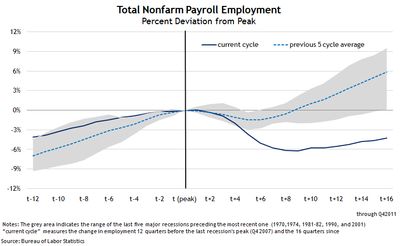
Others argue that recent job gains have been overstated, not intentionally, but by using exaggerated seasonal adjustments. Iacono Research has some interesting explanations and charts. Tim Iacono sees a problem looming in about a month, when the April jobs report is released. This chart shows why.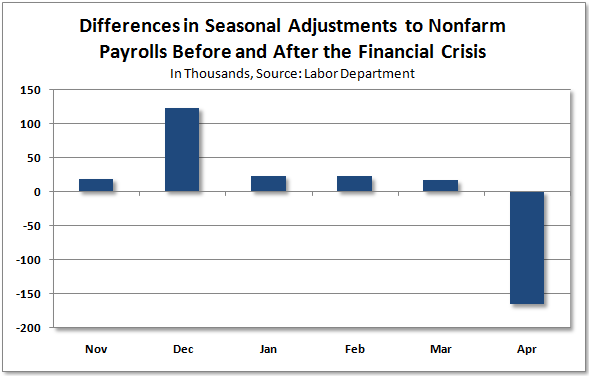
I will offer some thoughts for investors in the conclusion, but first, let us do our regular review of the week's data. For those who are trying to time the market with some simplistic formula, I urge you to read this week's conclusion.
Background on "Weighing the Week Ahead"
There are many good sources for a comprehensive weekly review. I single out what will be most important in the coming week. My theme is an expert guess about what we will be watching on TV and reading in the mainstream media. It is a focus on what I think is important for my trading and client portfolios.
Unlike my other articles, I am not trying to develop a focused, logical argument with supporting data on a single theme. I am sharing conclusions. Sometimes these are topics that I have already written about, and others are on my agenda. I am trying to put the news in context.
Readers often disagree with my conclusions. Do not be bashful. Join in and comment about what we should expect in the days ahead. This weekly piece emphasizes my opinions about what is really important and how to put the news in context. I have had great success with my approach, but feel free to disagree. That is what makes a market!
Last Week's Data
Each week I break down events into good and bad. Often there is "ugly" and on rare occasion something really good. My working definition of "good" has two components:
- The news is market-friendly. Our personal policy preferences are not relevant for this test. And especially -- no politics.
- It is better than expectations.
Despite the market reaction, there was not much to cheer about last week.
- Ben Bernanke hints at more QE? Well not really, but that was the market interpretation. I did not expect his speech to signal any policy change, nor did I hear one. But don't take my word for it. Here is the verdict from Tim Duy:
Dr. Ed also sees a continuation of current policy, even if there is more economic improvement. His take on the employment link includes this interesting chart showing unemployment and the perceived availability of jobs.
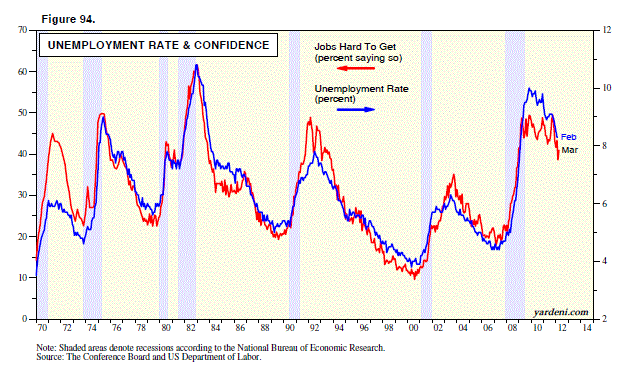
- Chinese PMI beats expectations reading 53.1 versus 50.5 expected. It was only a week ago that US markets were reacting to a weak "flash index" report and I warned that few understood these numbers. Here is a report that helps to explain why the strength might be overstated.
- The final revision to Q4 GDP had a hidden positive, the growth in GDI (Gross Domestic Income). Normally the two should be about equal, but GDI trailed for a bit causing skeptics to maintain that GDP was not an accurate indicator of the economy. GDI was up 4.4% vs 3.0% for GDP. The Bonddad Blog does a further analysis, noting the significance of the data to the ECRI recession argument.
- Michigan economists see improvement. As regular readers know, I have a soft spot for all things Michigan. I think this is a project from a grad seminar, but I read the alumni publication and I get to have fun also!)
- Michigan consumer confidence also edged a little higher to 76.2. I love the chart from Doug Short that shows at a glance the relationship to the economy and to recessions. Doug notes that despite recent improvement, the index is still significantly below the average for non-recession years (88.1). His article also has great charts for other confidence indicators.
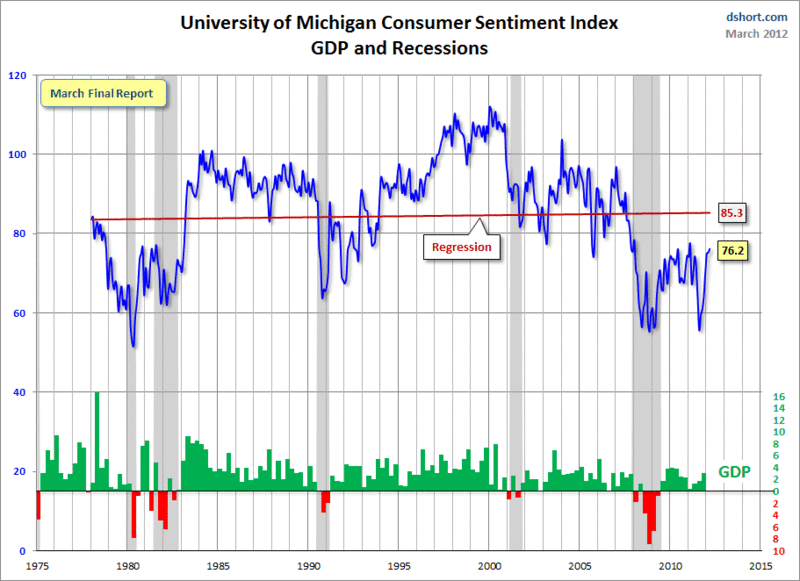
The Bad
Most of the economic news was negative. The economic releases, although not the most important, were all a bit light of expectations. I am reporting the verdict on the main items, those that I highlighted last week as important.
- Initial jobless claims were slightly lower, but that was only because the prior week was revised 16K higher. This makes the last two weeks a bit disappointing, with a new plateau of just over 350K. I have noted that this series only covers job losses, not job creation. This research note from the St. Louis Fed supports the idea that the series is helpful in predicting the job market during expansions, but not as good during recessions.
- Personal income trailed expectations. Personal spending was higher, but that cannot be sustained without corresponding income growth and was partly influenced by higher gas prices (also a continuing negative).
- The Eurozone bailout fund was increased to 700 billion euros, but this was the bottom end of expectations. It will require votes of approval by participating countries. The evidence so far is that the existing European policies (especially LTRO) have addressed imminent systemic risk, but done little to help the European economy. Rebecca Wilder is an economist specializing in fixed income markets and emphasizing Europe. She produces my favorite kind of argument -- one relentlessly driven by data. Her current conclusion is that the various policies have not yet helped the overall economy, but she concedes that the jury is still out.
You should read her entire analysis, but here is a sample chart:
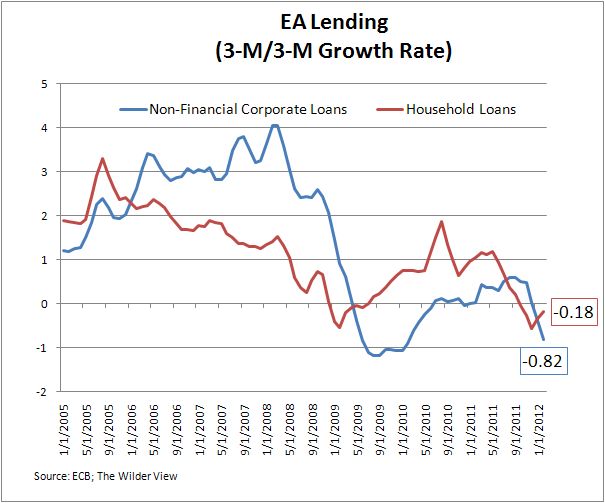
Spain. More austerity, slower growth, employee strikes, and higher interest rates. This will command attention from everyone. Spain is a likely candidate for the new bailout funds.
The Ugly
Congress: Always a candidate and often a winner. This week the House managed to come up with a symbolic vote, characterized as the Obama budget, but not really representing the exact proposals. The result was a stunning defeat, 0 - 414. Check out The Hill for the inside story.
I understand that the House wants to send a message about Obama policies. I know that it is an election year, and everyone is trying to win. Intended or not, the message to the public and to investors is that there is no leadership.
The Indicator Snapshot
It is important to keep the current news in perspective. My weekly snapshot includes the most important summary indicators:
- The St. Louis Financial Stress Index.
- The key measures from our "Felix" ETF model.
- An updated analysis of recession probability.
The C-Score is a weekly interpretation of the best recession indicator I found, Bob Dieli's "aggregate spread." I'll explain more about the C-Score soon. (I know that I am behind schedule on this. The message remains comforting.)
The SuperIndex from PowerStocks research is adjusting what information to make publicly available and in what time frame. I am a big fan of Dwaine van Vuuren, whose excellent statistical work is giving us better insight into a wide range of recession forecasting methods. The data point that I cite each week (the four-month recession outlook) is only one aspect of a comprehensive report. The SuperIndex includes nine different methods, including the ECRI. The analysis has a very strong, practical market application which has paid off richly for subscribers over the last few months. How? Mostly by putting the ECRI recession forecast into better perspective.
Here is the latest example, which does a great job of explaining the current ECRI changes in methods. Spend a few minutes at their site and you will see the following:
- A description of the SuperIndex components and methods.
- A collection of research reports, including how to improve the ECRI method, using the Conference Board's LEI, and deciding how much recession warning you need.
- A sample report. This shows the richness of the weekly information, including differing time frames for recession warnings as well as an updated GDP forecast.
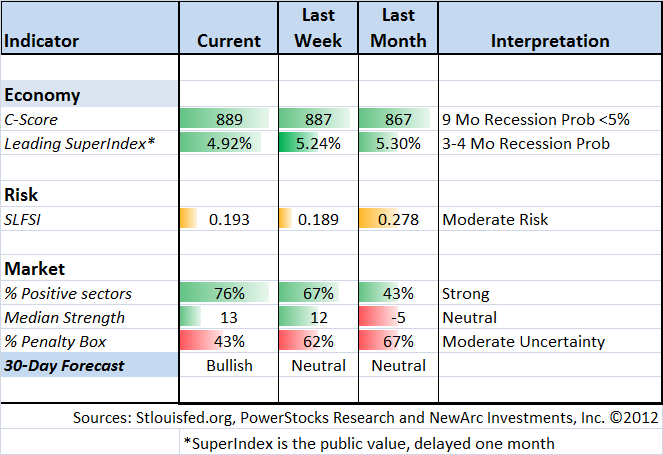
Our "Felix" model is the basis for our "official" vote in the weekly Ticker Sense Blogger Sentiment Poll. We have a long public record for these positions. This week we shifted to bullish after three weeks in neutral. This is a close call, but ratings are improving, including the broad averages.
[For more on the penalty box see this article. For more on the system ratings, you can write to etf at newarc dot com for our free report package or to be added to the (free) weekly ETF email list. For daily ETF commentary from Felix, you can sign up for Wall Street All-Stars, where I still have a few discounted memberships available. You can also write personally to me with questions or comments, and I'll do my best to answer.]
The Week Ahead
Employment is the big story this week, with the ADP private employment report on Wednesday, initial jobless claims on Thursday, and the employment situation report on Friday.
The Friday release of the most important economic data of the month creates an unusual situation, since US financial markets are closed for Good Friday. This means that traders will have no opportunity to adjust positions until the following Monday. It could lead to more volatility on Wednesday and Thursday based upon the ADP data.
In other important data we will see the ISM index on Monday -- very important in the current environment.
On Tuesday we have factory orders (still of interest) auto sales (very important) and the FOMC minutes (probably nothing special).
The ISM services index (Wednesday) is growing in significance, because the service sector is important, but it has a shorter history than the manufacturing index.
And of course....we have emerging events in Europe and China, where every small piece of data continues to command attention.
As we enter the close on Thursday, there will be more than the average three days of volatility.
Trading Time Frame
Our trading accounts have been 100% invested since December. Felix caught the current rally quite well, buying in on December 19th. There are more sectors in the buy range, and the overall ratings have improved. This program has a three-week time horizon for initial purchases, but we run the model every day and change positions when indicated. Felix has been more confident than I have been on the trading time frame, and has stayed invested in the face of a lot of skepticism. This illustrates the importance of watching objective indicators instead of headlines. Despite the modest overall ratings, Felix kept us fully and profitably invested for trading accounts, finding the bull market in selected sectors. We have 28 sectors in the universe, so we can be fully invested if there are three strong sectors, even if the market overall is neutral or negative.
Investor Time Frame
Long-term investors should be aware of the rapid decline in the SLFSI. Even for those of us who see many attractive stocks, it is important to pay attention to risk. In early October we reduced position sizes because of the elevated SLFSI. The index has now pulled back out of our "trigger range," and is declining further. This sort of decline has been a good time to buy stocks on past occasions. Worry is still high, but has now declined to a more comfortable level.
Even though stock prices are higher than in October, the risks are much lower. I continue to increase position size for risk-adjusted accounts. I am also looking more aggressively for positions in new accounts. This has been a challenge, since the market has offered only occasional dips to buy.
With new accounts I always have a basket of stocks that are especially attractive. I then try to fill out with additional names. Investors who are out of the market need to start somewhere, and might follow a similar approach.
The continuing reduction in volatility has helped our enhanced yield program, where we aim for 8-9% returns with low volatility. This week may provide some opportunities for new ideas.
Our Dynamic Asset Allocation model has become much less conservative. Gone are positions in bonds and gold. DAA responds to the message of the market, cashing in on extended moves. It is rather like what some call a "lazy portfolio" but better. The DAA approach is finding some of the best sectors over the last year.
Final Thoughts on Employment -- and the Fed
Measuring employment growth and unemployment is challenging. Even those who accept the honest intentions of the BLS (as I do) may have disagreements with the methodology.
I share concerns about the seasonal adjustment method (ARIMA X-12) and I think I have studied it more than most of the current critics. Two years ago I said that it would be a great project for a PhD candidate. I have worked with this method just enough to raise questions -- but not enough to provide answers. Stated simply, my concern is that changes in the trend are incorrectly interpreted as seasonal adjustments.
In general, I think this has worked to understate the rebound in employment. While this is based on my data, it is not something I can prove, nor can I take the time to do so. As I note in my warnings about the WTWA articles, I am sharing my conclusions, but I cannot always prove each contention.
Concerning Europe, I am wary and watchful with a continuing focus on US stocks that I believe to be insulated from these problems. I see the current "solutions" as only part of the story, with much more to come. The pace of solutions is now roughly matching the pace of new problems.
Concerning the Fed, many pundits and hedge fund managers have lagged by misinterpreting the Fed and/or demonizing Bernanke. It would be interesting to do a correlation study of returns of those using "Bernank" (which some seem to think makes them seem smart or superior) and those who do not. It is something of a litmus test.
And Finally -- for Market Timers
I have taken time to explain how many investors are making a big mistake with inappropriate market-timing methods.
- The Seduction of Market Timing. The secret of sales is to claim a lot, whether or not you can deliver.
- Do You Adjust Your Price Targets? Most do not -- and this ranges from market experts to the average investor. Unless you are constantly doing a re-evaluation, you are missing out.
At market tops, what percentage of stocks are above their 200-day moving average?
What percentage are above that level right now?
Which stock should you buy in your very next trade?
AI computing powers are changing the stock market. Investing.com's ProPicks AI includes 6 winning stock portfolios chosen by our advanced AI. In 2024 alone, ProPicks AI identified 2 stocks that surged over 150%, 4 additional stocks that leaped over 30%, and 3 more that climbed over 25%. Which stock will be the next to soar?
Unlock ProPicks AI